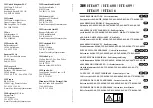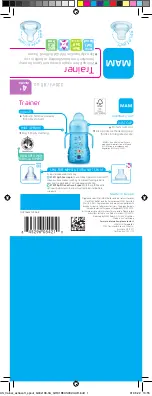
5. Loosen the screw securing the template and
rotate the template until the two tap guides line
up with the drilled holes. Push the #8-32 tap
into one of the tap guide holes to align the
template. Retighten the screw securing the
template.
6. Using the #8-32 tap, thread the two holes
through the template tap guides. Tap to a
minimum
5
/
8
” (16mm) depth, full threads.
Remove the template from the leg.
7. If installing a rosette array, repeat Steps 1
through 6 for the horizontal Microcell™.
8. Remove burrs from all the holes created.
MOUNTING MICROCELL™ SETS
CAUTION
Do not install Microcells™ in the rain. Do not
trap moisture under the environmental cover.
1. Wipe down a 5 in by 2¼ in (127mm by 57mm)
surface, centered on the template mounting
hole, with degreaser. This cleans the bare
metal and adjacent mounting surface for the
environmental cover.
2. Apply a thin coat of Kistler-Morse
®
rust
inhibitor to the bare metal surface for the
vertical Microcell™.
CAUTION
Do not apply rust inhibitor beyond this area, or
the environmental cover will not adhere
properly.
3. Connect the Microcell™ red, black, and white
wires to the corresponding terminals on the
Kistler-Morse
®
Test Meter. Turn on the power
to the Test Meter and set the Simulate/Test
Switch to the Test position.
Note
If a Kistler-Morse
®
Test Meter is not available,
refer to Appendix C (Alternate Method for
Checking Output) before proceeding.
4. With the cable end down, align a vertical
Microcell™ with its mounting holes. Fasten the
Microcell™ loosely to the leg using the two
#8-32 x
5
/
8
” socket head cap screws and
washers.
Do not tighten the screws.
If the
voltage goes outside the range -100mV to
+100mV, immediately loosen the screw(s).
Note
3” Microcells™ for vertical and horizontal
installation are slightly different. 3” Microcells™
for horizontal installation are labeled
“Horizontal.” 3” Microcells™ for vertical
installation are not labeled.
CAUTION
For proper installation, tighten each screw until
the T-handle driver flexes in torsion ¼ turn past
the point where the screw stops turning.
Repeat this flexing procedure several times to
ensure the screw is tight. When both screws
are tight, the voltage must be in the range
-100mV to +100mV. Follow the procedure in
Steps 5 through 7 to achieve this goal.
5. Using the T-handle driver, slowly tighten the
top screw. While turning the T-handle driver,
monitor the test meter carefully. If the
voltage goes outside the range -100mV to
+100mV while tightening, stop immediately
and evaluate the following:
A. If the voltage jumped outside the range
-100mV to +100mV, it may indicate a burr
or rough surface. Remove the screws
holding the Microcell™ to the leg. Check
for and remove burrs and surface
roughness (refer to SURFACE
PREPARATION for removing surface
roughness). Repeat Steps 1through 5.
B. If the voltage gradually moved outside the
range -100mV to +100mV, slowly loosen
the screw until the voltage is within range
again and proceed to Step 6.
6. Repeat Step 5 for the bottom screw. If the
voltage is outside the range -100mV to
+100mV, attempt to bring the reading within
range by loosening the screw being torqued,
tightening the other screw, or some
combination of loosening and tightening. If
you have difficulty staying within the range, try
turning each screw ¼ turn at a time until both
screws are tightened.
9
Содержание Microcell
Страница 20: ...Figure 3 18 Cutting Wrap Width Figure 3 19 Installing Brace Wrap 16 ...
Страница 22: ...Figure 4 2 Microcell Mounting Locations 18 ...
Страница 30: ...Figure 4 16 Wiring Junction Boxes Together Non Conduited Installation 26 ...
Страница 37: ...33 ...
Страница 42: ...38 ...
Страница 43: ......














































